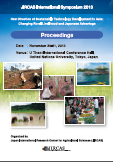Sustainable Agriculture Production by Biomass Utilization Technology

Biomass is an organic material of biological origin that is devoid of any fossil material and is continuously
renewed as long as there is life and solar energy. Biomass is carbon neutral, which means that it does not
contribute to the increase of carbon dioxide (CO2) in the atmosphere. Substituting fossil fuel-based energy
and manufactured products with biomass-derived fuel and products will markedly reduce greenhouse gas
(GHG) emissions, the primary cause of global warming.
First-generation bio-based energy and materials, such as sugar cane or cone, could contribute to reduced
CO2 emissions and improvements in energy security [1]. However, sourcing first-generation feedstocks
may have negative impacts on biodiversity, land use, and competition with food crops. The main
disadvantage of first-generation feedstocks is thus closely linked to food-versus-fuel and chemicals debate
[1]. Thus, in order to reduce GHG emissions, it is considered necessary to shift our attention to the
utilization of more efficient alternatives based on renewable and conventional technologies. Secondgeneration
feedstocks, such as agricultural wastes and forest and marine residues are mainly composed of
polysaccharides and do not compete with the production of human food and animal feed [2]. Secondgeneration
feedstocks are primarily composed of cellulose, a linear polysaccharide polymer consisting of
1,4-linked glucose units. Cellulose is a major constituent of plant cell walls and is thus considered to be
the world’s most abundant biopolymer [3, 4]. Glucose is particularly well suited for use as a carbon source
for feeding the bio-based economy, particularly since it can easily be converted into biofuels and chemical
compounds by microbes and enzymes.
The biomass that remains after conversion and fermentation could subsequently be processed into
biogas by anaerobic digestion, and any residual waste fractions could be converted into bio-oil or biochar
by pyrolysis [2, 5]. The biogas, bio-oil and fermentation residues produced in this way could then all be
used as an energy source, and the biochar produced at the end of the process is both carbon and nutrient
rich. Using the biochar to amend agricultural soil would also close the nutrient cycle and sequester
atmospheric carbon. This recycling of energy and nutrients could create a sustainable economy and society
[2], which could be attained by focusing on the fundamental biological processes of photosynthesis
(biomass production), conversion and fermentation (sugar platform), and waste management (agronomic
benefit), all of which should be considered technological cornerstones.
In this presentation, we would like to discuss the importance of biomass utilization technologies within
the context of agricultural sustainability. The JIRCAS biomass project focuses on the economical
production of fuels and chemicals from biomass through biological processes [6, 7]. Although the technical
and economic aspects of production still require considerable research, the outcomes of the project will
promote the development of sustainable social systems and improvements to rural livelihoods through
biomass utilization technologies.
| 刊行年月日 | |
|---|---|
| 作成者 | Akihiko Kosugi |
| 著者キーワード |
Biomass Sustainability Biomass utilization technology Biofuels Biochemicals Cellulose |
| 公開者 | Japan International Research Center for Agricultural Sciences |
| オンライン掲載日 | |
| 号 | 2013 |
| 開始ページ | 155 |
| 終了ページ | 161 |
| 権利 | Japan International Research Center for Agricultural Sciences |
| 言語 | eng |
